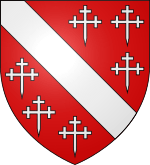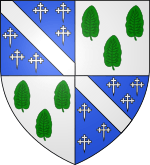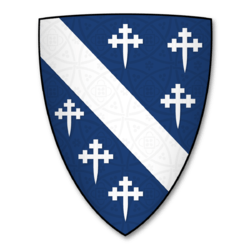Clan Cheyne
Clan Cheyne is a Scottish clan.[2] The clan is officially recognized by the Lord Lyon King of Arms, however as the clan does not currently have a chief recognized by the Court of the Lord Lyon, it is therefore considered an Armigerous clan.[2] The surname Cheyne is also recognized as a sept of the Clan Sutherland, and is accepted as such by the Clan Sutherland Society in Scotland.[3]



| Clan Cheyne | |||
|---|---|---|---|
| Motto | Patientia Vincit (Patience conquers)[1] | ||
| Profile | |||
| District | Aberdeenshire, Caithness and Sutherland | ||
 | |||
| Clan Cheyne has no chief, and is an armigerous clan | |||
| Historic seat | Esslemont Castle, Aberdeenshire[1] | ||
| |||
| |||
| |||
History
Origins of the name
According to the Collins Scottish Clan & Family Encycleopdia the surname Cheyne is of great antiquity and is believed to have been of either Norman or French origin.[2] The name apparently means Oak Plantation.[2] According to the historian George Fraser Black, some early clerics confused the word for "oak" with that of "dog" and in error they styled the name Canis.[2]
Origins of the clan
In 1158, Ricardus de Chanai witnessed a gift to the Hospital of St Peter of York.[2] However, the earliest record of the name in Scotland is that of William de Chense who witnessed a charter by William the Lion in about 1200.[2] From 1267 to 1269 Sir Reginald le Chain was Great Chamberlain of Scotland.[2] He held the lands of Inverugie as well as immense estates in Caithness.[2]
Wars of Scottish Independence
In 1320, a later Sir Reginald signed the Declaration of Arbroath.[2]
14th-century
Historian William Anderson stated that Sir Reginald le Chain who died in 1350 (or 1345) was survived by two daughters.[2] However, as he was renowned as a mighty hunter throughout the land, he longed for a male heir to succeed to his estates, but his wife gave birth to two daughters which Reginald had killed, or at least he thought he had killed.[2] The story goes that as the years passed and no male heir was born, that he saw two young ladies at a festival who far outshined the rest in beauty and accomplishment.[2] He expressed admiration for them to his wife and the cruel fate which had caused to him to order the death of his two daughters, which had they lived would have been about the same age as the two beauties.[2] His wife then introduced him to the two girls, confessing her justifiable disobedience that they were actually his own two daughters.[2] Sir Reginald Cheyne then acknowledged them as heirs to his lands of Esslemont, which had become the principal seat of the family through marriage to the heiress of the Marshall of Esslemont.[2]
Marjory, one of the two daughters of Reignald Cheyne married Nicholas Sutherland, 1st of Duffus, a branch of the Clan Sutherland, and as such the surname Cheyne is regarded as sept of the Clan Sutherland.[4]
16th-century
The Cheyne's Esslemont Castle was destroyed in the aftermath of a feud with the Clan Hay.[5]
Later clansmen
Sir William Cheyne (d.1932) was a distinguished surgeon and bacteriologist who was a pioneer of antiseptic surgical methods in Britain.[2]
Castles
Castles that have belonged to the Clan Cheyne have included amongst others:
- Inverugie Castle, in Aberdeenshire, was held by the Cheynes from the thirteenth century or earlier.[6]
- Esslemont Castle, Aberdeenshire, was held by the Cheynes until 1625.[6]
- Pitfitchie Castle, Aberdeenshire.[6]
- Ackergill Tower, Caithness, held by the Cheynes until passing to the Clan Keith in 1350.[6]
- Berriedale Castle, Berriedale, Highland, Caithness, held by the Cheynes but later passed to the Clan Sutherland.[6]
- Straloch Castle, New Macher, Aberdeenshire.
References
- "Clan Cheyne Profile". scotclans.com. Retrieved 18 September 2019.
- Way, George and Squire, Romily. (1994). Collins Scottish Clan & Family Encyclopedia. (Foreword by The Rt Hon. The Earl of Elgin KT, Convenor, The Standing Council of Scottish Chiefs). pp. 371 - 372.
- Clan Sutherland Society in Scotland – How to Join Us clansutherland.org.uk. Retrieved 14 April 2016.
- Sutherland Septs & Associated Families Archived 18 April 2016 at the Wayback Machine clansutherland.org. Retrieved 15 April 2016.
- Esslemont Castle medievalbritain. Retrieved 14 April 2016.
- Coventry, Martin. (2008). Castles of the Clans: The Strongholds and Seats of 750 Scottish Families and Clans. pp.99 - 100. ISBN 978-1-899874-36-1.
See also
- Scottish clan
- Armigerous clan
- Reginald Cheyne